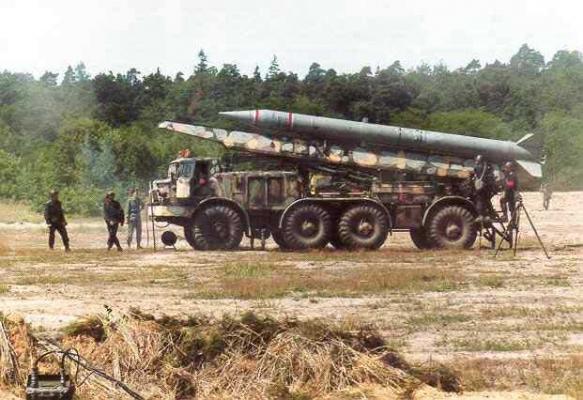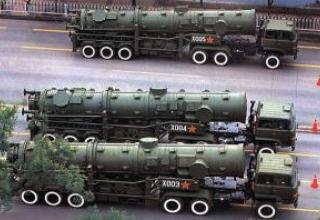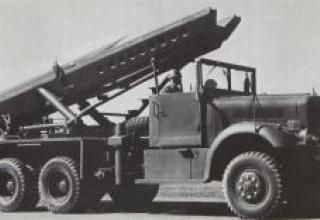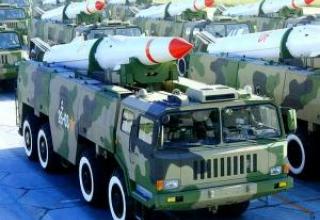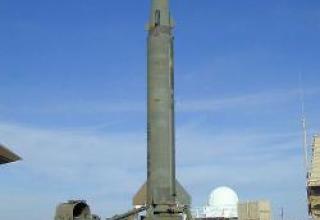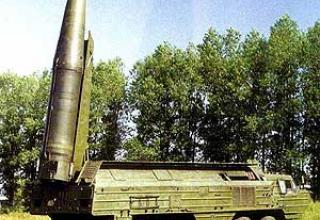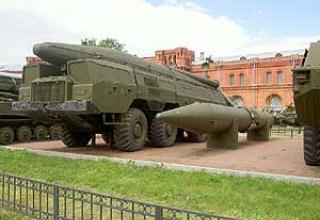In 1961, the Soviet Army adopted the "Moon" complex, which included a 2P16 tracked launcher based on the PT-76 floating tank, as well as 3P10 and 3P9 missiles with nuclear and shrapnel-flag warheads. Even before the Moon complex was put into service under the Decree of the USSR Council of Ministers of 17.02.1961, work began on developing its upgraded version with an extended range. These works resulted in the creation of actually new tactical complex, designated 9K52 "Luna-M". For this complex was created 9M21 missile, a new launcher and transport vehicle on wheeled chassis ZIL-135LM. The first launch of 9M21 took place on December 27, 1961, and the 9K52 "Luna-M" complex entered mass production and service in 1964. Series production was carried out at the Barrikada plant.
This complex became the most massive in the Soviet army, the peak of deployment of combat vehicles of the complex occurred in 1986, when they were in the army about 750 pieces. The version of 9K52TS system developed in 1968, designed for firing missiles with high-explosive warheads, was widely exported. Its buyers were the armies of about 15 countries, including the armed forces of the Warsaw Pact states, Cuba, Egypt, Iraq, Kuwait, DPRK. The complex made its military debut during the Arab-Israeli War of 1973. The "Luna-M" complex was used in a number of regional conflicts, including Afghanistan, the Iran-Iraq war of 1980-88, the Gulf war of 1991.
A significant drawback of the "Luna-M" complex was the low accuracy of firing, even the use of nuclear warheads did not provide guaranteed defeat of pointwise well-protected targets like command post, etc. In this connection, according to the Council of Ministers' resolution of 20.07.1966, the development of the "Luna-3" rocket equipped with a simplified control system was started. It was assumed that the circular probable deviation (CVO) of the new missile at a range of 70 km will not exceed 500 m . However, the flight tests conducted in 1968-1969 gave even greater circular deflection than the prototype. The range adjuster performed unsatisfactorily and continued work on this RCA was found to be impractical.
The 9M21 was also intended to be equipped with 9K53 Luna-MV missiles. Development of the complex "Luna-MV" was initiated by a decree of the Council of Ministers of 05.02.1962. This complex used the 9P114 launcher, created on the basis of a wheeled car, allowing landing by Mi-6 or Mi-10 helicopters. Work on the complex "Luna-MV" reached the stage of testing prototypes. However, there were quite a few difficulties, the main one was the need for a preliminary topographic binding of the starting position, as well as a large "sailing" helicopter Mi-10 with the launch unit 9P114 on the external sling. As a result, in 1965, work on this complex was stopped.
In the west, the complex was designated FROG-7.
Composition:
The complex 9K52 "Luna-M" includes:
- 9M21 missile (see schematic)
- launcher (PU) 9P113 on wheel chassis ZIL-135LM (see diagram)
- transport vehicle 9T29 on ZIL-135LTM chassis.
The advantage of complex 9K52 "Luna-M" over its predecessor was that PU had its own hydromechanical crane with a capacity of 3 tons (see photo from the side, top). This made it possible to abandon a semi-trailer transport vehicle that carried two spare rockets and a self-propelled crane to reload missiles. The 9P113 launcher provided a speed of up to 60 km/h on the highway, due to the use of the wheelbase of the jerks and overloads of the combat unit were significantly reduced (for the Moon complex the maximum speed theoretically was up to 40 km/h, but already at a speed of 16-18 km/h on unpaved roads there were overloads unacceptable for nuclear warheads). Both the 9P113 launcher and the 9T29 transport vehicle have very high cross-country capability. They are capable of overcoming elevations up to 30° steep and fords up to 1.2 m deep.
The 9P113 is capable of at least 200 launches of 9M21 missiles. For fixing the launcher during the launch of the missile four hinged supports with screw jacks are used. PU 9P113 is equipped with a hydraulic drive device for installation of a guide to the launch position of the missile, as well as the necessary equipment for prelaunch preparation and launch. There are also communication facilities, navigation and orientation equipment, power supply and life support systems.
The 9M21 unguided single-stage solid fuel missile is designed to engage manpower, military equipment, firepower and defensive structures located in the tactical depth of enemy defense. The missile was designed in several variants, differing in combat units: 9M21B with a 9N32 nuclear warhead, 9M21F with a 9N18F shrapnel-flagged warhead, 9M21G with a 9N18G chemical warhead, and even 9M21D with a 9N18A propaganda warhead. The 9N18F fragmentation combat unit contained 200 kg of highly effective TGA-40/60 explosives and produced at least 15,000 fragments. In 1969, was adopted for service 9H18K cassette-type shrapnel head unit weighing 420 kg, containing 42 combat elements weighing 7.5 kg and providing for the defeat of manpower on an area of several hectares.
Since the 9H32 head units in nuclear equipment required maintenance of a constant temperature regime to ensure a given blast power, and in the head units of the Lunar-M there was no internal heating system, the 9P113 launcher and 9T29 transport vehicle were equipped with electric heating thermowells designed to maintain the temperature of nuclear warheads in a given temperature regime. The cover itself had a temperature sensor, which enabled the heating spirals to be switched on and off depending on the temperature. The number of thermal covers coincided with the number of transported missiles (for 9P113 - 1, for 9T29 - 3). To ensure the heating of the GC during long stops without starting the marching engines in the composition of the above units was a benzo unit located on the left side of the road between the third and fourth bridge.
The 9M21 rocket unit consists of three engines, a start engine, a main marching engine and a turn engine. All engines are solid-fueled. The different ranges of the rocket (see diagram) are achieved by using brake plates, as well as by changing the elevation angle at launch (see diagram of the trajectory). The launch engine is placed around the main engine nozzle. It operates while the missile is moving along the PU guides. The ignition of the launch engine charge is generated by the main engine gases penetrating through special holes. The launch engine charge is made of single-channel cylindrical PCI-60 gunpowder balls arranged in three rows around a circle. The main (marching) engine provides a given range of the rocket. It operates only on the active section of the trajectory, and then the flight is carried out by inertia. The main engine charge consists of single-channel cylindrical checkers made of nitroglycerin (ballistic) powder NMF-2. Armored ends of checkers hold the charge in the combustion process, provides alignment of the missile. The gunpowder charge is divided into two parts by its length. Each part is held in the chamber of the rocket engine by its diaphragms, which approximately halves the load at the mounting points. The operation of the RDTT is noticeably affected by the initial temperature of the charge, which ultimately affects the engine thrust. This factor can be eliminated by adjusting the elevation angle of the guideway prior to launch. In addition, the 9M21 missile uses interchangeable nozzle bushings with different critical cross-section diameters. At elevated temperatures, bushings with a larger critical cross-section are used, while at lower temperatures, the opposite is true.
The rocket engine is launched by injecting an electrical impulse through the onboard connector into the pyropatroons, initiation of which leads to the ignition of a ignitor made of granular smoke powder, which, in turn, ignites the powder charge of the main engine. The rotation motor serves to compensate for the moment caused by the eccentricity of the thrust vector and is located in the center of the rocket mass. The engine nozzles are led to the side surface of the rocket by means of curved gases, the thrust vectors of the rotation engine are directed tangentially to the hull surface and create the torque. The engine of rotation works on powder of mark РСИ-60, time of operation ~ 0.4 s, it is switched on after descent of a rocket from guides. In a tail part 9М21 the stabilizers providing steady flight of a rocket on a trajectory are established.
Rockets of all modifications have the largest hull diameter of 544 mm, the length of rockets of modifications 9M21B, F, E is 8960 mm, rockets of modifications 9M21B1 and E1 are 9400 mm. The missile's flight speed is about 1200 m/s.
When calculating the data for the launch of 9M21B rocket take into account weather conditions, namely, the direction and average wind speed at an altitude. For this purpose, the launch battery has a weather unit, which fires several shots vertically upward from the ballistic gun. The direction and distance of incidence of the bullets (daytime with a red ribbon, nighttime with a glowing one) from the point of the shot is calculated, and the wind direction and average speed are calculated. To prevent unauthorized use of nuclear weapons, all launchers capable of launching missiles in nuclear equipment are equipped with code-locking devices. The 9K52TS launchers, which did not involve the use of warheads in nuclear equipment, have no code-locking devices. PU 9K52TS was not equipped with thermal covers, as there is no need to heat the head units.
Characteristics:
| Rocket 9M21 | |
| Caliber,mm | 540 |
| The length of the rocket, mm | 8960 - 9400 |
| Weight of projectile, kg | 2432-2486 |
| Mass BC (OFBH, YBH), kg | 200-450 |
| Mass BC (HBC), kg | 36 |
| Range of fire, km: - maximum - minimum |
68-70 12-15 |
| Accuracy (dispersion),m | 500-700 |
| PU 9P113 | |
| Base | ZIL-135LM (8х8) |
| PU weight together with rocket, kg | 17560 |
| Number of guides, pcs. | 1 |
| Guide length, mm | 9970 |
| Angle of elevation of the guideway, degree: - maximum - minimum |
65 15 |
| Angle of horizontal guidance, degree | ±7 |
| Maximum speed, km/h | 60 |
| Power reserve, km | 850 |
| Crane load capacity, kg | 3000 |
| Time to prepare the BM for firing, min. | 15-30 |
| Calculation, man. | 7 |
Testing:
The first flight test of the XMG-M52C "Lance" rocket with extended range was conducted at White Sands Range on March 6, 1969. The first series of missiles entered the army for military trials in April 1971. The first launch took place in August 1972, and in March 1972 the military trials were fully completed.
In May 1972, the missile system "Lance" was officially recognized as a protocol model of military equipment and was classified as a class "Standard A". However, only a Lance missile with a nuclear warhead was included in this class, as Congress had not yet approved the development of a cluster bomb head unit, which the command of the ground forces considered necessary to have in service.
Immediately after the approval of the missile, the delivery of the Lance missile system to NATO partners and Israel began. Six divisions were formed in Europe. Two of them were in Germany, which could not but bother the USSR Armed Forces group "Center": the flight time of the Lance missile is only about 200 seconds, so there was no way to quickly detect and shoot down the missile. Missiles equipped with non-nuclear head units were delivered to Israel.
There are reports that the Lance missile system was used by U.S. forces during the war in Afghanistan in the late 70's and early 80's.
In the mid-80s, the Lance missile system was withdrawn from service due to the nuclear arms reduction treaty between the USSR and the United States. Currently, the Lance missile is used as a target for anti-missile testing. There is evidence that it is used in the development of the US national missile defense program.
Sources:
- Энциклопедия Кирилла и Мефодия.
- Щербаков Б.Ф. " Наземные оперативно-тактические ракетные комплексы: учеб.пос. БГТУ,СПб,2008г., 161с
